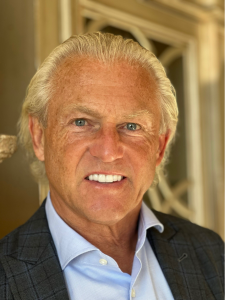Chris Lischewski on Navigating Disruption and Preparing Future Leaders for Success
With global markets struggling due to increasing uncertainty related to digitization, economic shifts, and changing consumer preferences, Lischewski highlights the need for flexibility, foresight and resilience. “In my series of lessons for business leaders, I have highlighted 7 mantras for business success that senior executives can use as guiding principles to not only manage disruption but also leverage it to create new opportunities,” says Lischewski.
Chris Lischewski, President of Golding Farm Foods, is a seasoned industry leader with decades of experience in revitalizing struggling companies and driving success. He believes that leaders today need to focus on continuous innovation, flexibility, and a commitment to mentor future leaders.
Embracing Change as an Opportunity
Lischewski stresses that change should be viewed as a catalyst for growth rather than a threat. "The journey to business success is rarely straightforward," he notes. "It's a winding road filled with unexpected turns and challenges. To thrive, companies must be nimble and ready to pivot when necessary". This adaptability starts at the top; leaders must model this behavior by being open to new ideas and challenging existing methods.
Seven Mantras for Business Success
Lischewski has outlined seven essential mantras or rules that senior executives can use as guiding principles to manage disruption effectively while leveraging it to create new opportunities. These principles focus on organizational vision, mission, values, structure, adaptability, innovation, strategic thinking, leadership development, and embracing change as an opportunity for growth rather than just reacting defensively against it.
Continuous Innovation: A Key Driver of Competitive Advantage
For businesses to stay ahead in today's competitive environment, fostering a culture of continuous learning and innovation is crucial. This involves encouraging teams to explore new technologies, skills, and business models that drive competitive advantage. By doing so, companies can position themselves at the forefront of their industries.
Agility: The Ability to Pivot Quickly
Businesses that can respond quickly to market shifts are more likely to succeed. Agile leadership involves making informed decisions swiftly while embracing flexibility across all levels of the organization. This agility allows companies not just to react but proactively shape their future by seizing emerging opportunities before competitors do.
Mentoring Future Leaders: Ensuring Sustainable Growth
Sustainable growth requires investing time in mentoring future leaders who possess the skills necessary for success in dynamic global markets. Great leaders empower others by cultivating strategic thinking within their organizations. By instilling resilience and adaptability into future generations of leaders through mentorship programs or talent development initiatives they ensure these individuals are equipped not only to withstand disruptions but turn them into catalysts for growth.
Leadership Style: Transformative Vision Combined with Operational Discipline
Chris Lischewski’s career is marked by transformative vision combined with operational discipline—a combination he believes is essential for enduring success. His experience includes leading StarKist Seafood through significant restructuring efforts such as expanding global operations and positioning Bumble Bee Foods from bankruptcy into a billion-dollar enterprise. His emphasis on building strong teams aligns with his belief that no leader achieves success alone; thus empowering others becomes essential.
Preparing Future Leaders Through Strategic Thinking
To prepare future leaders effectively:
● Develop Strategic Thinking: Encourage critical analysis while fostering innovative solutions.
● Instill Purpose: Align organizational goals with broader societal values.
● Foster Resilience: Equip teams with tools needed not just weather storms but leverage change into opportunities.
By adopting these strategies businesses better navigate today’s volatile environment positioning themselves long-term under capable leadership.
Shawn G.
Global PR
email us here
Legal Disclaimer:
EIN Presswire provides this news content "as is" without warranty of any kind. We do not accept any responsibility or liability for the accuracy, content, images, videos, licenses, completeness, legality, or reliability of the information contained in this article. If you have any complaints or copyright issues related to this article, kindly contact the author above.
SANBlaze Announces Industry's First NVMe Gen6-Capable SSD Test System
Todd Mezrah Launches $2,500 Scholarship for Future Leaders Committed to Community Service
Todd Mezrah Announces $2,500 Business Athlete Grant for Resilient College Students
Więcej ważnych informacji
 Jedynka Newserii
Jedynka Newserii

 Jedynka Newserii
Jedynka Newserii

Konsument

Grupa nowych biednych emerytów stale się powiększa. Ich świadczenie jest znacznie poniżej minimalnej emerytury
Przybywa osób, które z powodu zbyt krótkiego czasu opłacania składek pobierają emeryturę niższą od minimalnej. Tak zwanych nowych biednych emerytów jest w Polsce ok. 430 tys., a zdecydowaną większość grupy stanowią kobiety – wskazują badania ekspertów Instytutu Pracy i Spraw Socjalnych. W ich przypadku krótszy okres składkowy zwykle wynika z konieczności opieki nad dziećmi lub innymi osobami w rodzinie. Wśród innych powodów, wymienianych zarówno przez panie, jak i panów, są także praca za granicą lub na czarno oraz zły stan zdrowia.
Media i PR
M. Wawrykiewicz (PO): Postępowanie z art. 7 przeciw Węgrom pokazało iluzoryczność tej sankcji. Unia wywiera naciski poprzez negocjacje nowego budżetu

Przykład Węgier pokazał, że procedura z artykułu 7 traktatu o UE o łamanie praworządności nie ma mocy prawnej z powodu braku większości, nie mówiąc o jednomyślności wśród pozostałych państw członkowskich. Negocjacje nowego budżetu UE to dobry pretekst do zmiany sposobu części finansowania z pominięciem rządu centralnego. Czerwcowy marsz Pride w Budapeszcie pokazał, że część społeczeństwa, głównie stolica, jest przeciwna rządom Viktora Orbána, ale i na prowincji świadomość konsekwencji działań Fideszu staje się coraz większa przed przyszłorocznymi wyborami.
Firma
Blockchain zmienia rynek pracy i edukacji. Poszukiwane są osoby posiadające wiedzę z różnych dziedzin

Zapotrzebowanie na specjalistów od technologii blockchain dynamicznie rośnie – nie tylko w obszarze IT, ale również w administracji, finansach czy logistyce. Coraz więcej uczelni wprowadza programy związane z rozproszonymi rejestrami, które wyposażają studentów w umiejętności odpowiadające wymogom rynku.
Partner serwisu
Szkolenia

Akademia Newserii
Akademia Newserii to projekt, w ramach którego najlepsi polscy dziennikarze biznesowi, giełdowi oraz lifestylowi, a także szkoleniowcy z wieloletnim doświadczeniem dzielą się swoją wiedzą nt. pracy z mediami.


![Nestlé w Polsce podsumowuje wpływ na krajową gospodarkę. Firma wygenerowała 0,6 proc. polskiego PKB [DEPESZA]](https://www.newseria.pl/files/1097841585/fabryka-nesquik_1,w_85,r_png,_small.png)






.gif)

 |
| |
| |
|